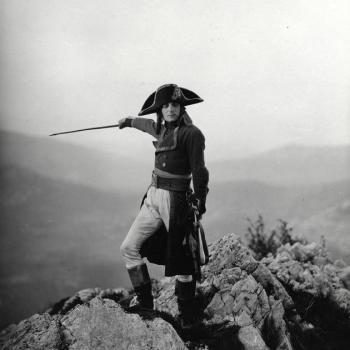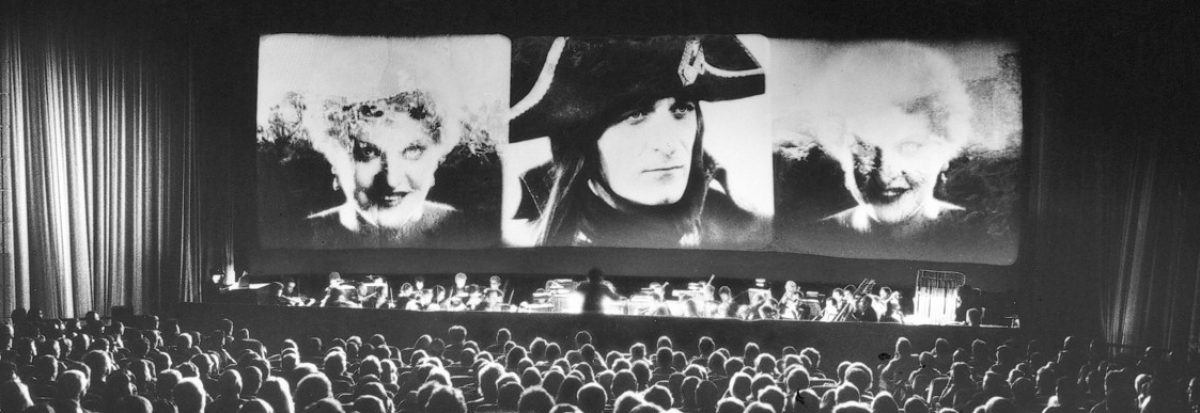By 1918, Mauritz Stiller was one of Sweden’s leading filmmakers. He had joined Svenska Bio in 1912 and worked variously as actor, screenwriter, and director. After making dozens of shorter films in a variety of genres, he was tackling larger subjects with bigger budgets. His next production would be his largest to date: an adaptation of Johannes Linnankoski’s Finnish novel Laulu tulipunaisesta kukasta (1905). In June 1918, Stiller began shooting his exteriors around the river Faxälven, and the nearby towns of Långsele and Sollefteå. The production lasted until August, taking advantage of the lengthy summer evenings and natural locations. Shot by Ragnar Westfelt and the great Henrik Jaenzon (brother of the equally great cameraman Julius Jaenzon), the film would show off the technical prowess of Swedish cinematography and the beauty of the country’s landscape. After finishing shooting the interior scenes in Svenska Bio’s studios in Stockholm, the film was released in April 1919. The musical accompaniment for its first screening was created by the Finnish composer Armas Järnefelt—the first score specially written for any Swedish film. Stiller’s production was a tremendous critical success, both within Sweden and throughout Europe. The strategy of adapting Scandinavian literature for the screen came to dominate Stiller’s work and that of Swedish cinema into the 1920s. Indeed, by the time Sången om den eldröda blomman premiered, Stiller had already nearly finished shooting his next film, Herr Arnes pengar (1919)—an adaptation of Selma Lagerlöf’s novel. The first of many…

Sången om den eldröda blomman follows the adventures of Olof (Lars Hanson), son of the wealthy farmers of Koskela. Tempted first by Annikki (Greta Almroth), he then attracts the attention of Elli (Lillebil Christensen). The pair are caught in a compromising situation by Olof’s mother (Louise Fahlman), and both Olof and Elli are ejected from their homes for their behaviour. Each goes in a different direction from their village, Olof going to work as a log driver on the river Kohiseva. Here he encounters the proud Kyllikki (Edith Erastoff), who he decides to impress by riding on a log through the Kohiseva rapids. Their romance blooms briefly, but Olof feels he cannot settle and—after a fight with some locals and a confrontation with Kyllikki’s father (Hjalmar Peters)—heads to the city. Here he drifts into a seedy underworld of brothels, where he encounters Elli. This chance meeting drives each to despair at where their lives have led: Elli kills herself, an act which drives Olof back to his homestead. He finds that his parents have died, so he returns to the one woman who was prepared to live with him: Kyllikki.

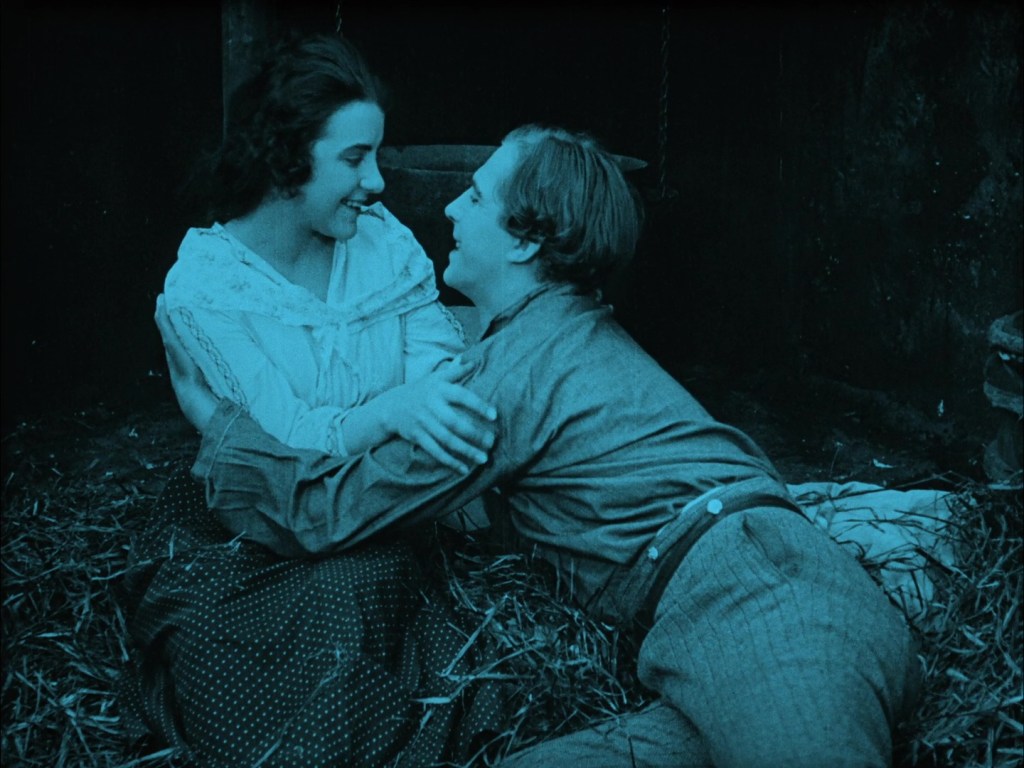

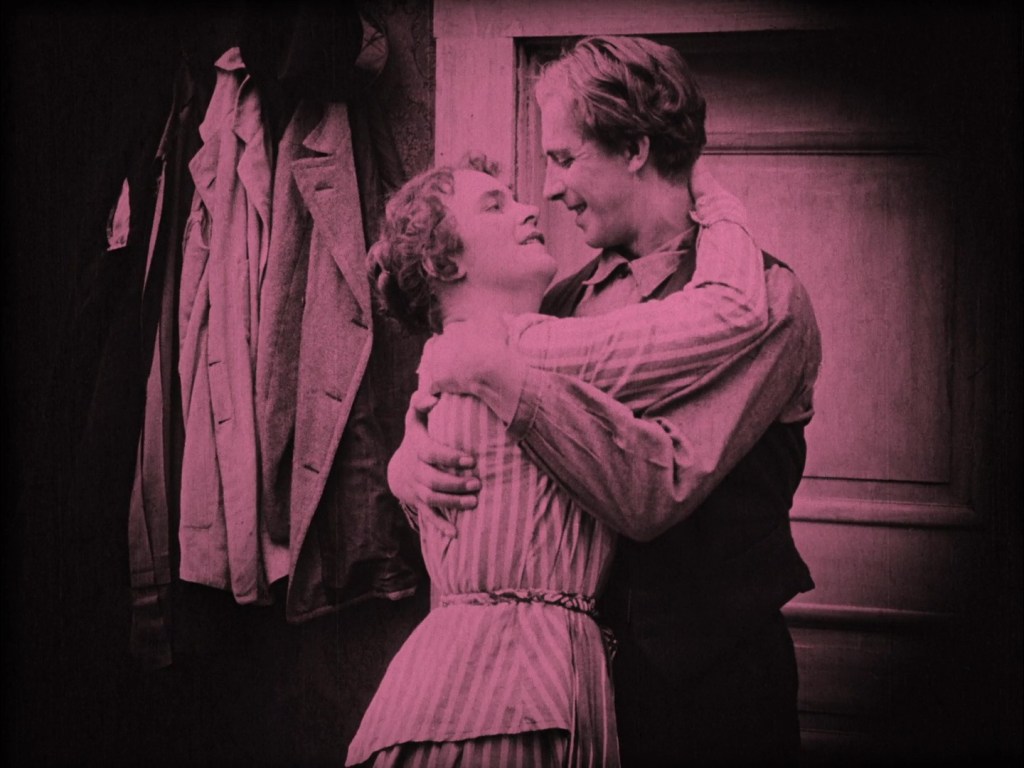
Having recently watched Stiller’s Gunnar Hedes saga (1923), I can say that Sången om den eldröda blomman has a more engaging story and fewer storytelling impediments. The film shows its literary sources only in the poetic titles that begin each “chapter” (in fact, each reel of the original seven-reel film) and, unlike in Gunnar Hedes saga, there are no awkward visual metaphors inserted into the telling. Though Stiller simplified the story of the original novel—which is more of a Don Juan narrative than the film—it still has a sense of ebb and flow, together with a cumulative power by the final two chapters.
It also made me think this must have been a more personal endeavour for Stiller. The Finnish source material for Sången om den eldröda blomman has some clear emotional resonances with Stiller’s life. Like Olof, Stiller was an outsider: he was an orphan, a Jew, a homosexual, a Finnish-Russian filmmaker working within Sweden, then a Swedish filmmaker working within Hollywood. His childhood was defined by his mother’s suicide and his early adulthood by having to flee to Sweden to avoid conscription in the imperial Russian army. He had to rebuild his life in a foreign land to which he was in every way a foreigner. Sången om den eldröda blomman shows us a man forever on the move, first being ejected from his maternal home, then finding itinerant work in places on the outskirts of towns. He is always on the outside: he meets lovers in remote patches of forest, perched on hills away from civilization. We see him on numerous doorsteps, facing rejection: on the steps of his native Koskela, on the steps of the Moisio farm, in the doorways of the city streets. He doesn’t have a home, a place to settle. Spending most of his time with menfolk at work, he nevertheless sits awkwardly among them: he is prone to rash acts, he gets into fights, he lashes out in rage. (Stiller himself had a famous bad temper.) The story may not have a neat trajectory, but its episodic nature slowly builds up a compelling characterization.




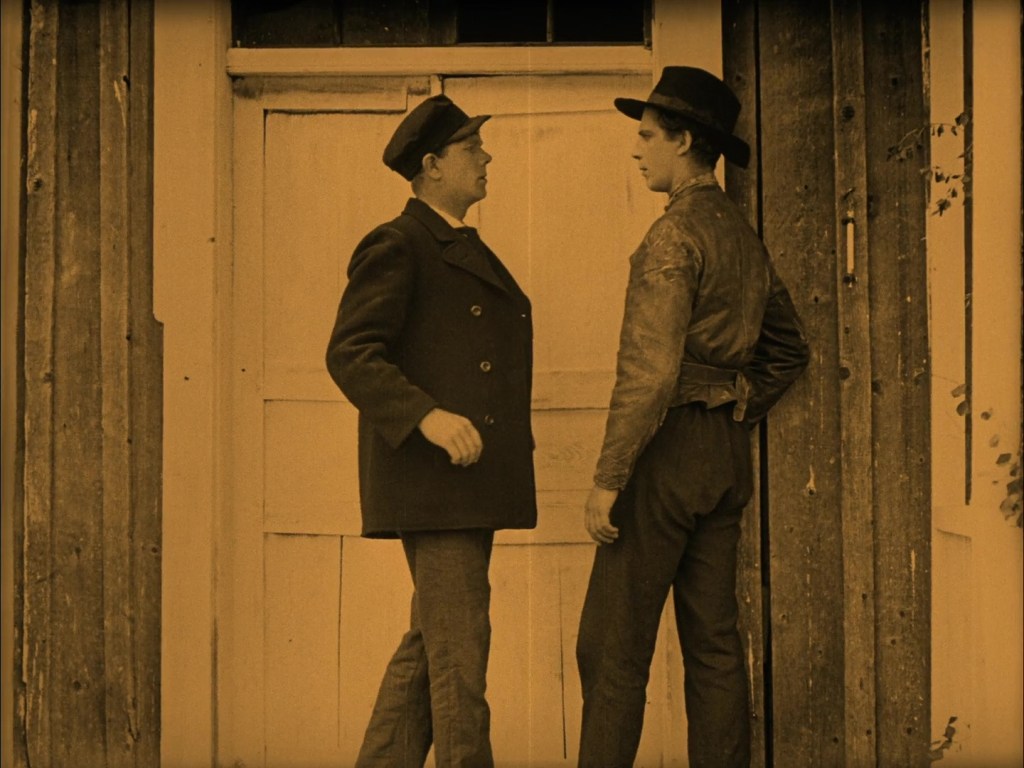


Which brings us to Lars Hanson. Of those that I’ve seen of his performances, this is perhaps my favourite. He’s incredibly beautiful to look at, and manages to present aspects of youthfulness and of experience. There are scenes when he looks barely twenty, and others when he might be forty. The narrative offers him great scope to show off his range. He is by turns wilful, impetuous, violent, tender, vulnerable, grieving, joyful. His performance—and the performances across the cast—are naturalistic, free of odd tics and too much exaggeration. There is an emotional transparency throughout: Hanson signals what his character is feeling through subtle gestures rather than melodramatic ones.





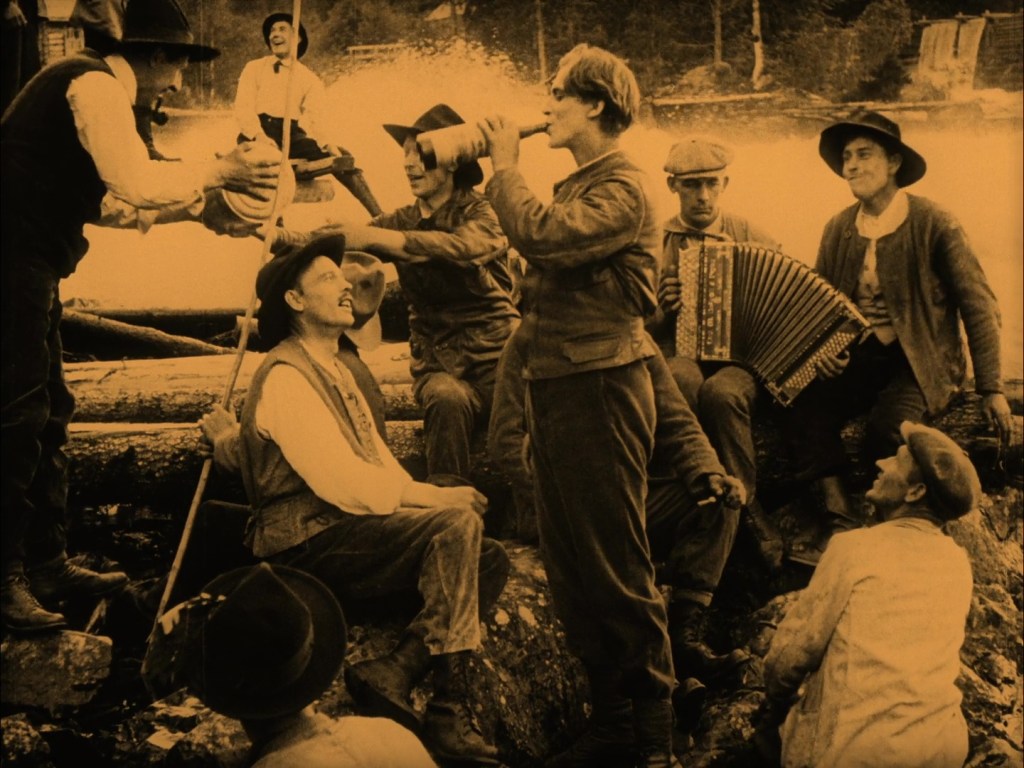



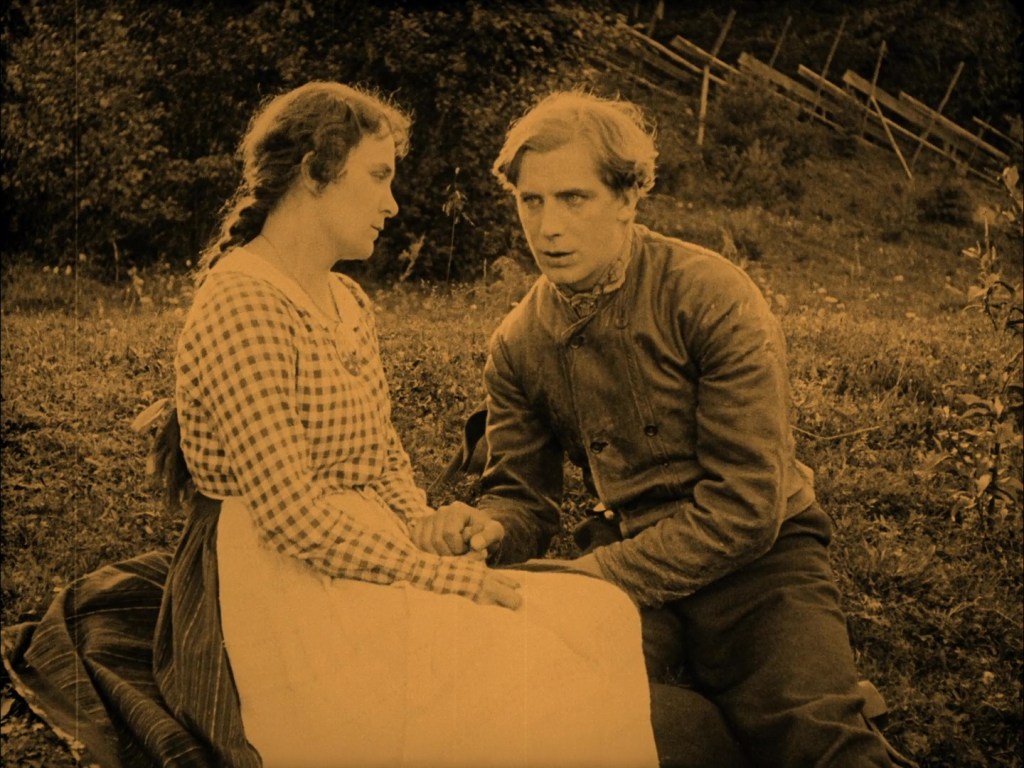




In the penultimate chapter of the film, the scene in which Olof confronts himself in a mirror is a superb combination of performance and direction. Stiller only lets Olof—and us—sense the mirror by framing it almost side on, on the wall overlooking the character. Olof starts to turn his head right, then left. He turns up his collar. Only now does Stiller cut to a frontal view of Olof and the mirror. The glass is angled downward to avoid revealing the camera shooting the scene, but it also serves as a brilliant way of suggesting Olof being overlooked: the mirror is practically peering down at him from the wall. And Hanson’s doubled performance is marvellous. Stiller now cuts between Olof in the room and the reflection in the glass. For the latter, he keeps the corner of the frame in view. The way the reflected figure reaches out, it seems as though the hand might even stretch beyond this frame, into the real space of the bar. And Hanson’s performance as the reflected Olof is wonderfully sinister: it’s an exaggerated version of the facial range we have seen, but only slightly. The raised eyebrow, the widened eyes, the furrowed brow—they are both recognizably his, but weirdly, disturbingly different. Even without the trickery of the mirror scene in Der Student von Prag (1913), this scene is a perfect moment of cinematic uncanniness.

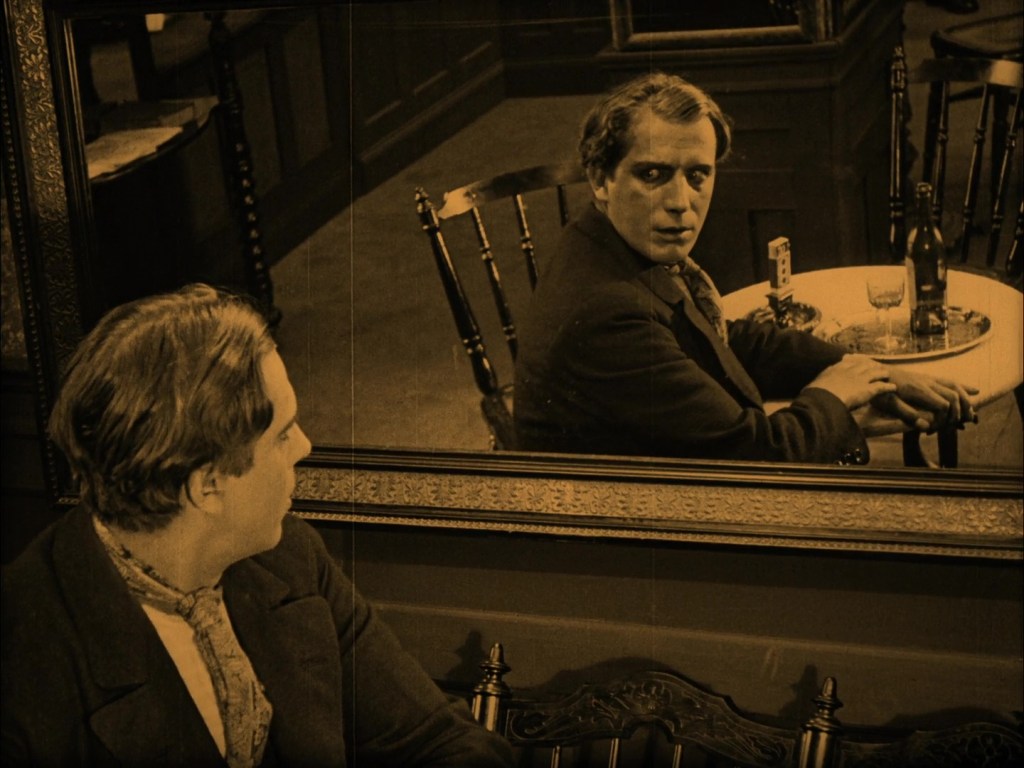




If there are scenes of such complex staging and framing, there are also plenty of rougher, less tidy, aspects of Sången om den eldröda blomman. It’s more of an outdoors film, and there is a kind of roughness in the editing that seems to suit the episodic nature of the story and its rural setting. It’s not merely that Stiller is working outside the so-called “rules” of “continuity editing”. It’s also that he has no interest in neatness or prettiness for its own sake. Stiller is not interested in spatial continuity, but emotive continuity—Stiller places the camera where is needed, where he wants, not where it should go.


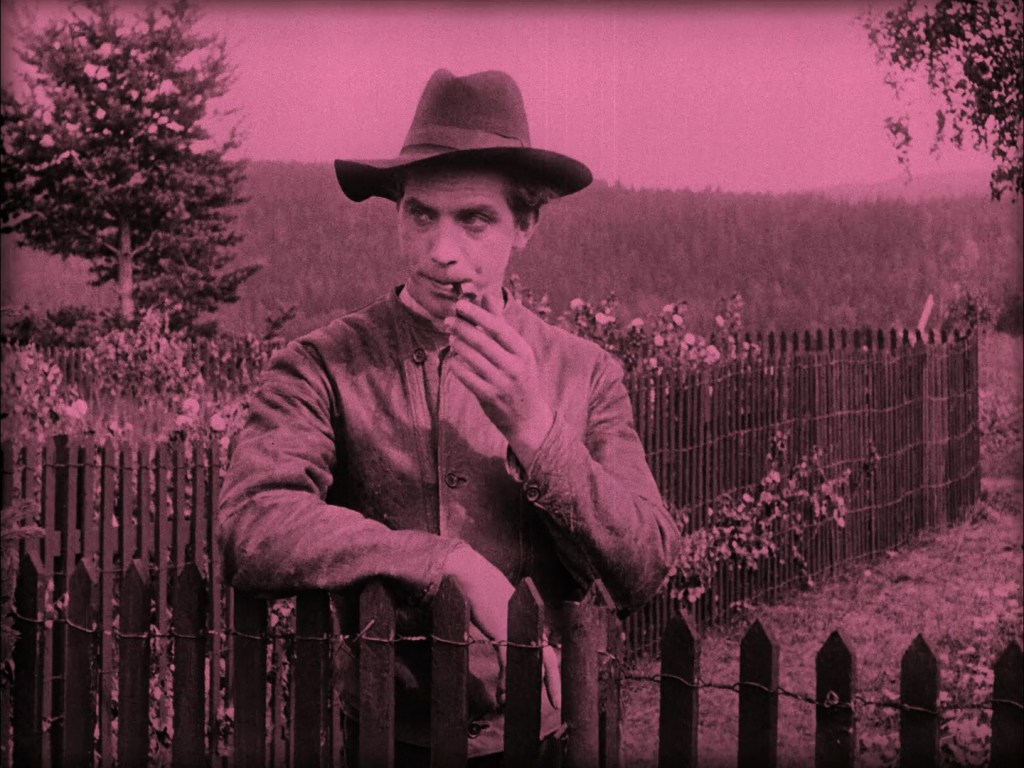


Just look at the last scene, set at the Moirio farm, when Olof comes to claim Kyllikki and must confront her father. The interior space is filmed from the outside, then through doorways, then from both behind and in front of Olof. Stiller has interest in showing the initial framing: it echoes the various earlier scenes in which Olof has stood in doorways, always coming or going, and in the mirror scene where his presence within the frame on the wall finally “reveals” what he has become. But once Olof has entered the space, Stiller cuts according to feeling. We see Olof from behind, looking out into the room; then from front on, his back to the door he has just come through. Once Stiller gets all three characters inside this space, he cuts freely from whatever angle he chooses. He wants us to see the emotion on their faces, the way they stand according to each other. It doesn’t matter if it means cutting across lines of sight or viewpoint. Such editing is dynamic, even if it is sometimes disconcerting—perhaps even because it is disconcerting. After all, the scene is about rearranging expectations: Olof is returning to Kyllikki, Kyllikki is disobeying her father, her father and Kyllikki finally discover the history of Olof’s family. Why not film this scene of changing roles, of upended assumptions, in a way that pays no heed to established space or perspective? The scene works. That’s all that matters.







I’ve said that Sången om den eldröda blomman is an “outdoors” film, but this undersells what it achieves with its exterior shooting. Quite simply, this is one of the most beautiful, immersive natural environments you could hope to see on screen. I’ve already gone through the film three times for this review, and every time I gape in wonder at the richness of the photography. Though just about every shot is populated by at least one character, the whole film is defined by the world we see around them.












Olof meets Annikki just as he has felled a tree. They sit surrounded by immense pines, suffused with warm summer light. When they dance, they do so against great expanses of grass bordering by the river. When Olof encounters Kyllikki, we see the farmland behind her, the river before her; the rose garden and the rose itself becomes the place and emblem of their romance. When Olof rides the rapids, we see the huge expanse of water, the shifting tempo of the river, the rocks of the valley, the forests at its edge.





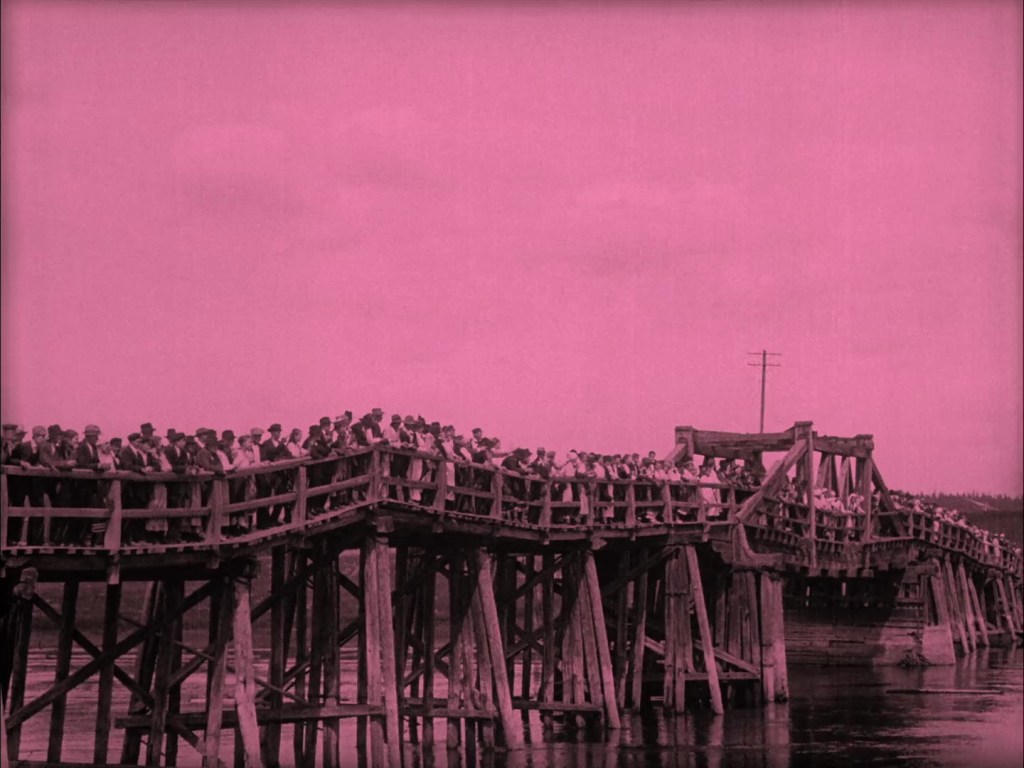








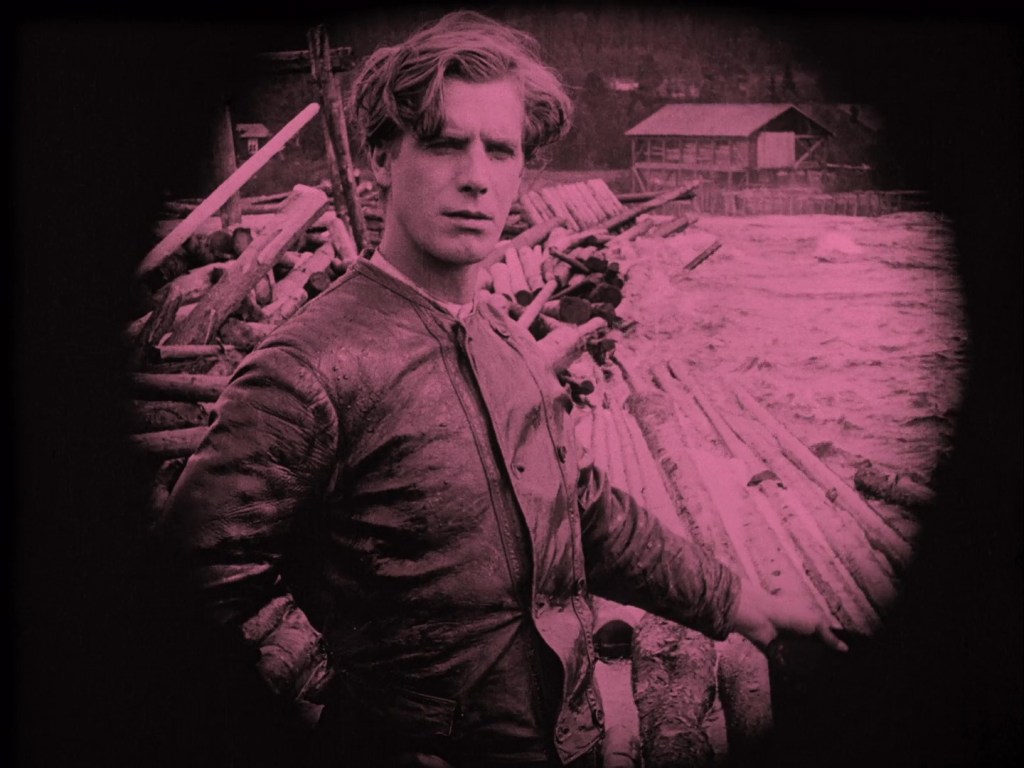
Conversely, when Olof enters the city, at his lowest moral point in the film, the streets are encased in darkness: there is no sense of sky, of space. Furthermore, it’s raining for the only time in the film. The city glistens with a kind of sweat. Clothes and attitudes and morals are all affected by this dark, grim, sodden climate.





All this sense of place, of time, of atmosphere and mood, is enhanced by the tinting and toning. The whole film is in some way coloured, giving an even greater sense of tone and warmth to the images of landscapes. From memory, the restoration from the 1980s was coloured via the Desmet process, a rather crude method of overlaying a colour image on top of a monochrome one. This results in some rather thick, flat colours in many of the earlier restorations of Swedish silents of this period. The earlier restoration of Sången om den eldröda blomman that I’d seen looked far muddier, had far less depth and detail to the colour. In particular, the rapids sequence is utterly transformed by the 2017 digital restoration: the subtle blue toning brings out all the depth and texture of the rocks and trees in the background, leaving the highlights of the swirling, foaming rapids deliciously white. The images are so crips, so detailed, so textured—it’s a real revelation.



But what really, really makes the images in this film work is the score. My word, I’ve been waiting a long time to hear this original score. I’m familiar with some of Järnefelt’s orchestral music, but this score represents the largest work of his I know—indeed, it’s the lengthiest single work in his entire oeuvre. He studied in Berlin and Paris in the 1890s, then (with his wife, the singer Maikki Järnefelt) lived in Germany and worked as a rehearsal pianist and assistant conductor in several opera houses. Returning to Scandinavia, he earned a growing reputation as a conductor, first in his native Finnish city of Viipuri (1898-1903), then in Helsinki (1904-07), and finally at the Royal Opera in Stockholm (1907-32).
Järnefelt never wrote an opera, but he did write much incidental music for the stage—ideal training for silent film music. Being possessed “by an insane Wagner fever” as a youth (and mounting numerous opera productions of Wagner during his time in Helsinki), there are some aspects of recurring motifs in his score for Sången om den eldröda blomman (see Korhonen, 4). There also seems, to me, to be at least one direct nod to Wagner in the score, albeit a subtle (which is to say, quiet!) one. The lengthy passage for solo oboe at the start of the seventh, final, chapter is surely influenced by an equivalent scene in Wagner’s Tannhäuser (1845). Act 1, scene 3, of the opera opens with a lengthy, seemingly improvised, passage played by a shepherd, who sits alone on stage. (In fact, his “pipes” come from an offstage cor anglais.) The image of the lone shepherd is matched on screen in Stiller’s film, as is the fact that the hero of the film is, like Tannhäuser, a man torn between restless physical wants and the desire to settle and find love. Like Tannhäuser, Olof is a pilgrim returning to his home from the “sinful” city. (The title of the film’s final chapter is “The Pilgrimage”, after all.)



But this talk of Wagner is misleading, since Järnefelt’s score is far lighter than Wagnerian music-drama. It’s written for a small orchestra, with parts for flute, oboe, two clarinets, two horns, trumpet, trombone, percussion, piano, harmonium, first and second violins, viola, cello (En afton på Röda Kvarn, 216). In style and tone, it evokes the soundworld of Scandinavian—specifically, Finnish—“national romantic” music. The music is evocative of time and place, somewhat nostalgic even, and makes plentiful use of folk tunes and “rustic” timbres. The use of harmonium as part of the orchestral texture is a particular delight: at times it hints at a religious mode (Olof at the graveyard), at others it evokes the sound of an accordion (the dance scenes). There are leitmotivs for various scenes/characters (Elli and Olof, Olof and Kyllikki), but they are deliberately clear and simple to follow—again, this isn’t a Wagnerian score.
Indeed, the simplicity of the musical structure (which uses plenty of repeats, as well as recurring motifs) was necessitated by the arduous process of composing music for a silent film in this period. Järnefelt later recalled:
I had to build up metre by metre, bit by bit. I received a list of the principal scenes of the film and their durations; but that information proved to be quite wrong, as the film was screened at a much faster pace, and I was horrified to discover how poorly music and image went together. I was obliged to shorten the score. Never in my life had I had to write music in such a way, that I was forced to confirm to the tempo of events—I, who am used to setting the tempo myself! In the end, it all finally worked out. (qtd in Korhonen, 6)
It did indeed “work out”. Though following the broad strokes of the action on screen (the rhythm of the dances, the rivers), and often evoking the sounds occurring in the scene (the sound of the fiddler, the distant hymn from a church), the music is more interested in providing a wider tonal sense of mood for each scene.
Listen to how the score introduces the Moisio farm, where Olof will see and fall for Kyllikki. Under the strings, piano and woodwind spell out a undulating motif; it’s like the burble of the river in the distance, or like the wheatfield that we see rippling in the wind. With this music, the image becomes one of dreamlike wonder. I’ve said how Stiller’s editing is sometimes “rough”. I might better describe it as “open”. The lack of clinical continuity means there is more room for the landscapes to dominate our sense of place, to define a broader imaginative geography. Wherever Stiller places his camera, there is something marvellous to find. Each new shot seems to reveal some new angle, to open some new window onto this world. I could just stare and stare and stare at these landscapes forever.

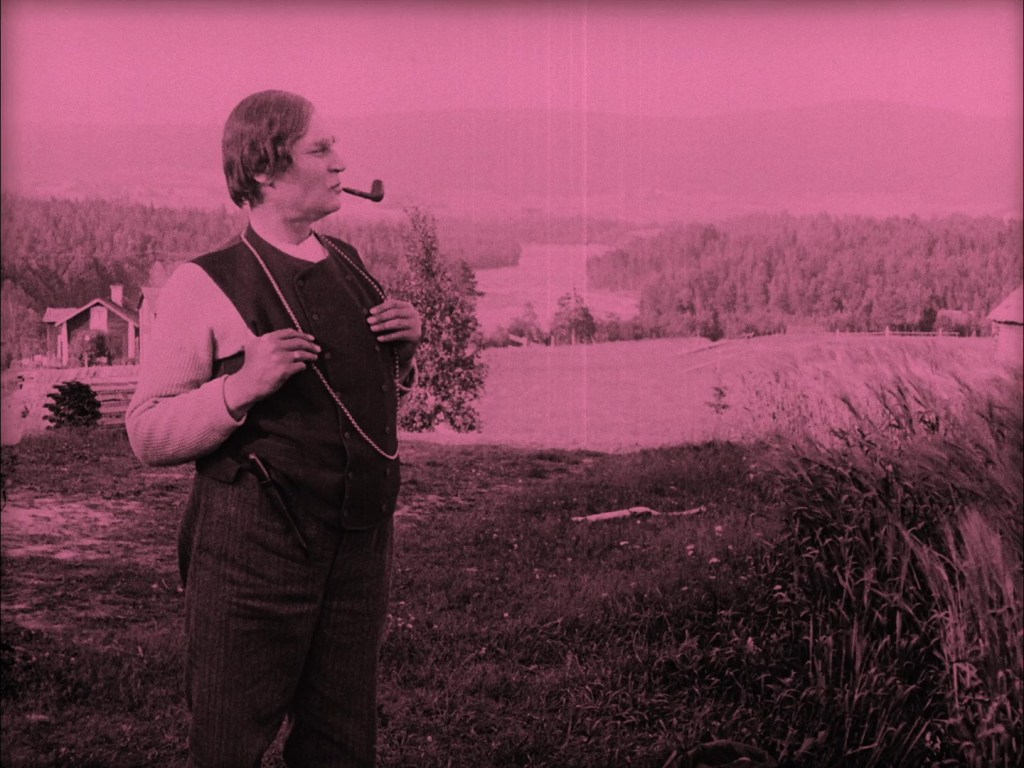

Look at the scene when, after proving himself worthy of her, Olof tries to explain why he cannot stay with Kyllikki. They are sat in a forest clearing, overlooking the great swathe of valley and river in the distance. It is evening. The light is exquisitely warm, diffuse. The amber tinting makes you feel the warmth radiating from the trees, from the hills in the distance, from the two bodies at the centre of the image. Järnefelt captures all of this perfectly: in his orchestra, the strings are a bed of calm. It’s an acoustic impression of sunset, of a kind of summery hum, sweet and sad and tired. Over this sound, a solo clarinet casts a slow, dreamy melody and is eventually joined by the clarinet. The two instruments then engage in a languorous, anxious exchange above the hushed strings. The lovers are gently haloed by the evening sky behind them. Christ, Jesus, it’s beautiful to look at, to listen to. I could perch here forever with these lovers—long dead, now—and watch them talk in silence, and listen to the music float over these golden images, arrested from the past. Scenes like these are why I love silent cinema. Iris-out to black.







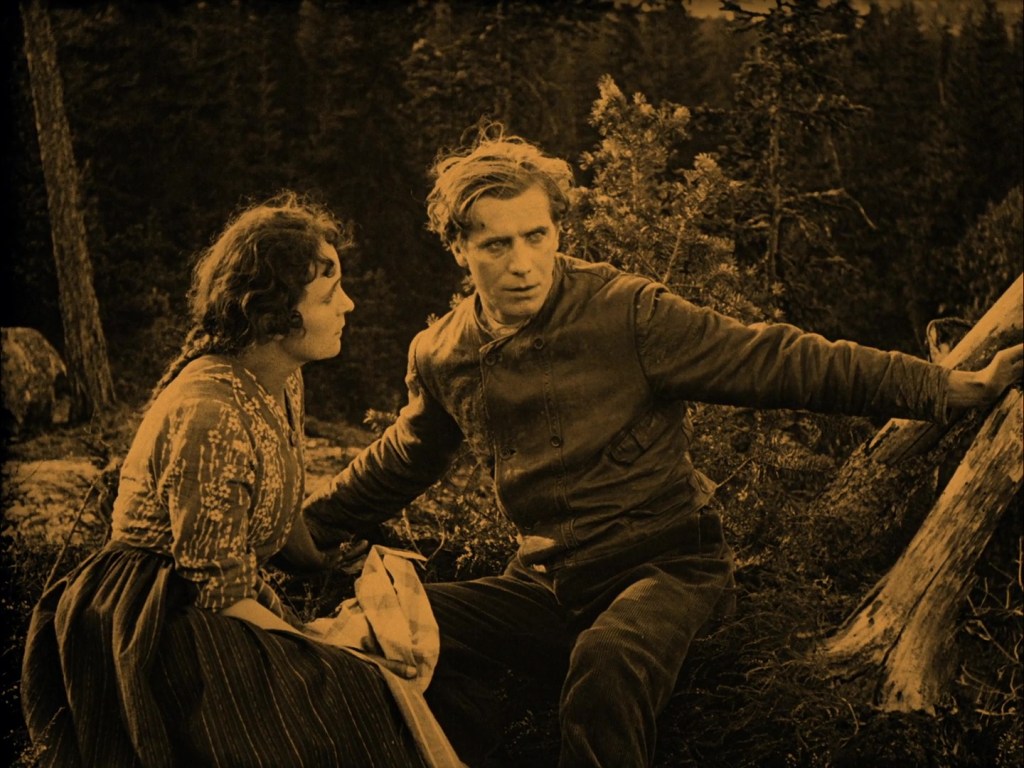
I must conclude by saying something about the restoration itself. The film was digitized in 2017 by Svenska Filminstitut from “a 35mm b/w dupe negative and a tinted and toned positive nitrate”. In terms of content, it’s the same as the version restored in the 1980s that has been available in various guises since then. But for its presentation on Netflix, there are no notes on how this version compares to that seen in 1919. Looking up the film on the Swedish Film Institute database, I find that the original length was 2657m (across seven reels). The database gives a projection speed of 16fps, making the film 145 minutes when first shown. As presented on Netflix, there is no technical information about the sources used for the 2017 digitized version. How long is it in metres? What frame rate does it have? How does it relate to earlier versions of the film? These are the kinds of questions that must be asked of any silent film, and any decent restoration should be accompanied with at least a few notes on its history. Frustrated by this, I looked elsewhere and spent a tiring but ultimately rewarding morning digging out more information…
My starting point was the CD release of the complete orchestral score (available on the Ondine label). I say “complete”, but Kimmo Korhonen’s liner notes for the CD release are far more informative on this subject than any online notes about the film restoration. Korhonen refers to Ann-Kristin Wallengren’s thesis on music in Swedish silent films, which contains a chapter on Sången om den eldröda blomman and the history of Järnefelt’s score (En afton på Röda Kvarn, 210-45). The music was performed at screenings across several Swedish locations, and was still extant as late as 1931, when Järnefelt conducted extracts of the score for recording. After this, nothing more was heard until the 1980s. As Wallengren relates:
When I started my research, the sheet music for Sången om den eldröda blomman was considered to have been lost long ago. However, after many long telephone conversations, the Finnish Broadcasting Company were quite surprised to find in their holdings the complete orchestral parts. However, the score was still missing. On a loose sheet among the orchestral parts, it was noted that the score and conductor’s part were lent to the composer in 1938. By searching for survivors in Järnefelt’s estate inventory, I found the material in the possession of a relative who kindly lent everything for copying. The score and conductor’s part are now also available at the Finnish Broadcasting Company. (En afton på Röda Kvarn, 214)
After finding this material, a version of the score was assembled for performance in 1988. But by this time, a significant portion of the film had been lost. Sången om den eldröda blomman was released in its full length in April 1919, then rereleased in a shortened version in June 1920. Neither the 1919 nor 1920 versions survive compete, so the 1988 restoration was nearly 45 minutes shorter than Järnefelt’s score, which accorded to the version of 1919 (ibid., 213). Various arrangements of the score were made to accompany the 1980s restoration, and an edition orchestrated by Robert Israel was performed at various screenings in the subsequent years. However, to accompany the new digital restoration of 2017, a new arrangement of the score was made. For this, Jani Kyllönen and Jaakko Kuusisto were able to work from Järnefelt’s own manuscript score and the orchestral parts preserved from the original performances in 1919. The recording made in 2018 therefore offers the exact orchestration that Järnefelt presented in 1919, even if not all the music written for the film can be accommodated in the surviving film material. (It’s a shame that the double-CD release couldn’t include more of the music either!)
As so often, this complex history is not even hinted at in the online publicity for the 2017 restoration—at least as far as its release via Netflix is concerned. Another (minor) frustration with this presentation is the way Netflix have encoded the subtitles. The translations seem passable (though the informal idiom of much of the dialogue is lost, as if the lyricism of the poetry), but the timing and placement of the subtitles make it difficult to follow all the original information on screen. This is because the subtitles are held on screen for the whole length of the original title (which is more than enough time to read each line in translation), leaving no time to look at the original text alone. And because the subtitles don’t bother translating the actor credits that appear at the bottom of many titles, you can’t actually read the original text: the credits remain buried under the subtitles. Thanks to this technical decision, I was unable to see the name of the main characters being introduced (together with the name of the performers). It’s such a simple thing but getting it right would have made a big difference to the viewing experience. I do hope this is fixed if/when the film gets a physical release.

On the theme of new presentations for Swedish silents, the Järnefelt score made me want to hear more contemporary music arrangements from this context. Even if specially written scores like Sången om den eldröda blomman are the exception for Swedish films of this period, how many compiled scores (i.e. cue sheets) survive for other films—and therefore could be recreated? Wallengren’s thesis mentions dozens of films for which the musical cues are known to some degree. But Sången om den eldröda blomman is one of the only examples where the original music has been used for a digital release. Many Swedish silents on DVD have modern scores by Matti Bye, whose work was attached to numerous restorations from the 1990s-2000s. These are perfectly acceptable scores, but I find aspects of them very frustrating. Bye has a habit of instructing his string section to improvise atonal chaos at moments of suspense (the image of carriage wheels in Körkarlen (1921)) or high drama (the fight scene in Gösta Berlings saga (1924)) that drives me mad. These outbursts of musical violence (I am tempted to say musical ugliness) are at odds with the rest of the scores and with the films themselves. Bye’s music rarely moves me in the way the films do. I’d be deeply curious to experience the films with the kinds of music that audiences might have heard in the 1910s-20s. For the premiere of Victor Sjöström’s Körkarlen at the Röda Kvarn in Stockholm, on New Year’s Day 1921, music was arranged by Eric Westberg. This was based around the music of Ture Rangström, together with works by Mendelssohn, Sibelius, Saint-Saëns, and Reger. With respect to Matti Bye, I’d rather hear music by any of the above.
And if, as Wallengren outlines, this was the standard mode of presentation for films presentation in silent-era Sweden, then we should try and recreate it. If films by Sjöström and Stiller had assembled scores rather than original ones, then it’s a valid and important historical task to recreate what these might have sounded like. Wallengren also explains that even music specially written for a particular film was frequently reused to score other films. Thus, Järnefelt’s music for the rapids sequence in Sången om den eldröda blomman was reused for the similar scenes of the rapids in Stiller’s Johan (1920)—together with six other lengthy pieces from his work. Several of these same pieces were reused for Stiller’s Gunnar Hedes saga and again for Gösta Berlings saga. This kind of borrowing even extended to imported film music. For use in performances of Gösta Berlings saga, music was also taken from the score arranged by Louis Silvers and William F. Peters for Griffith’s Way Down East (1920) (En afton på Röda Kvarn, 141). I’d love to see all these films with the music arranged for them at the time, even if it means hearing the same pieces used and reused in different ways. It’s gorgeous music, so why not hear it more often? When else will you get a chance to hear new recordings of Järnefelt’s work? And beyond the familiar soundscapes of Grieg and Sibelius (or even Nielsen), Scandinavian orchestral music of the early twentieth century—by Hugo Alfvén, Kurt Atterberg, Rued Langgaard, Wilhelm Peterson-Berger, Ture Rangström, Johan Svendsen, et al.—is a great, untapped resource for anyone wishing to arrange contemporary music for silent films.
If I’ve talked about the music for so long, it’s simply because it made such a huge impact on my viewing experience of this film. Seen and heard in this quality, Sången om den eldröda blomman is hypnotically beautiful, emblematic of all the great qualities of Swedish cinema in its “golden era”. I was utterly entranced. With Järnefelt’s original score restored, this is the single best presentation of any silent Swedish film I know. More restorations like this, please.
Paul Cuff
References
Kimmo Korhonen, ‘Song of the Scarlet Flower: A Pioneering Nordic film score’ (trans. Jaakko Mäntyjärvi), Liner notes for Armas Järnefelt: Song of the Scarlet Flower (Full score to the 1919 film), Ondine, ODE1328-2D, 2019.
Ann-Kristin Wallengren, En afton på Röda Kvarn. Svensk stumfilm som musikdrama, PhD Thesis, Lund University, 1998 [available online].
